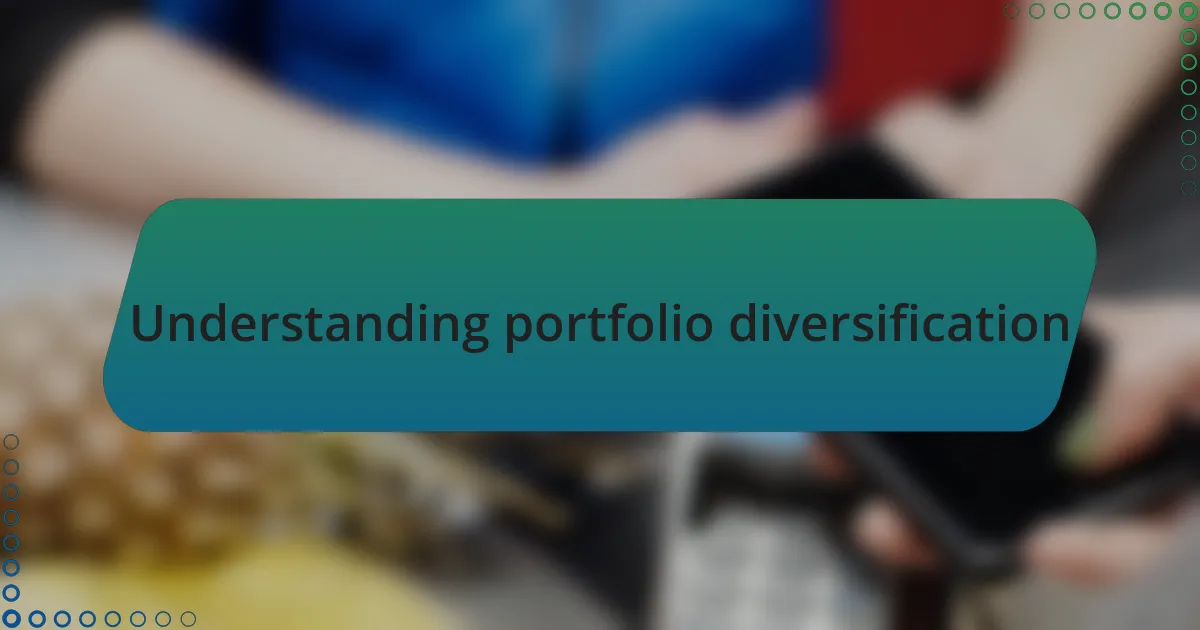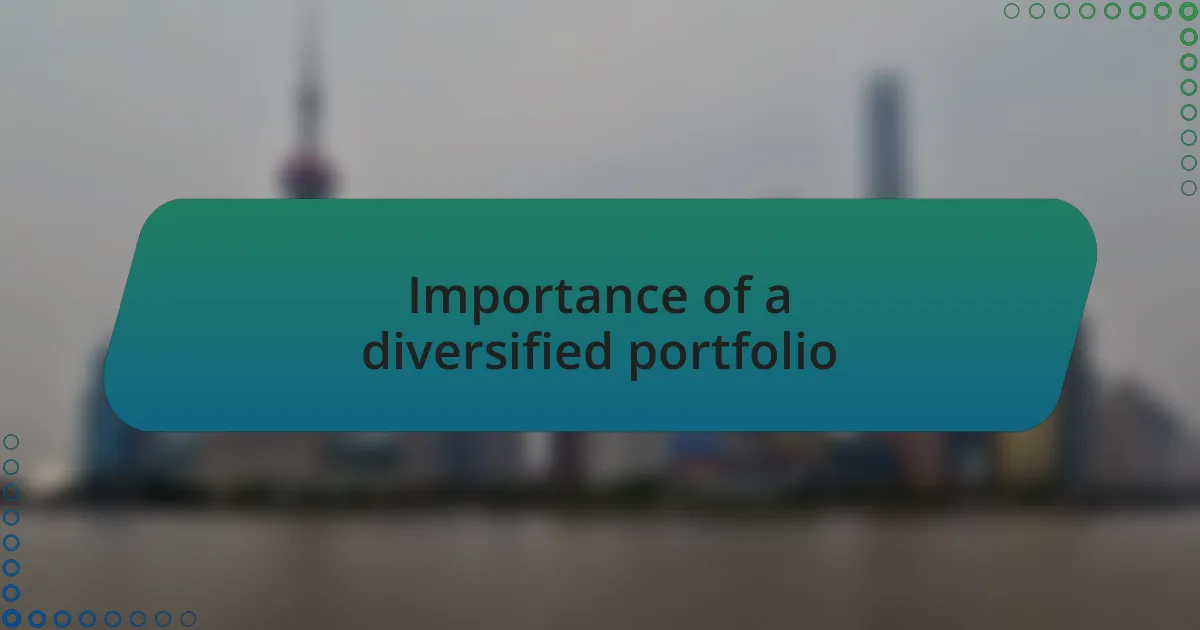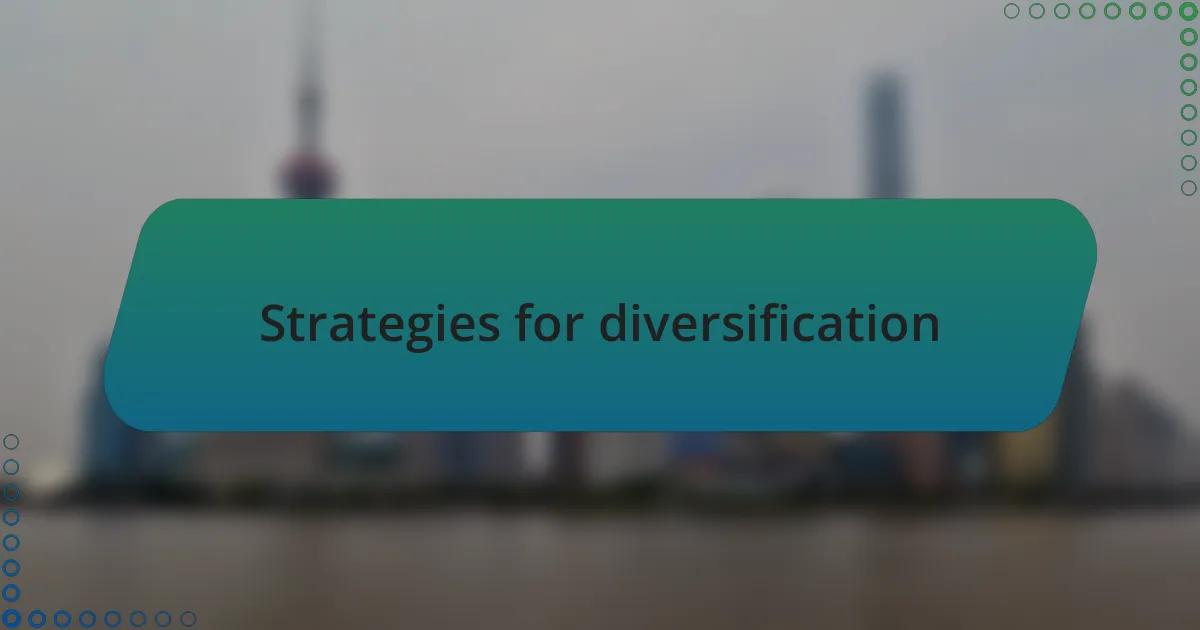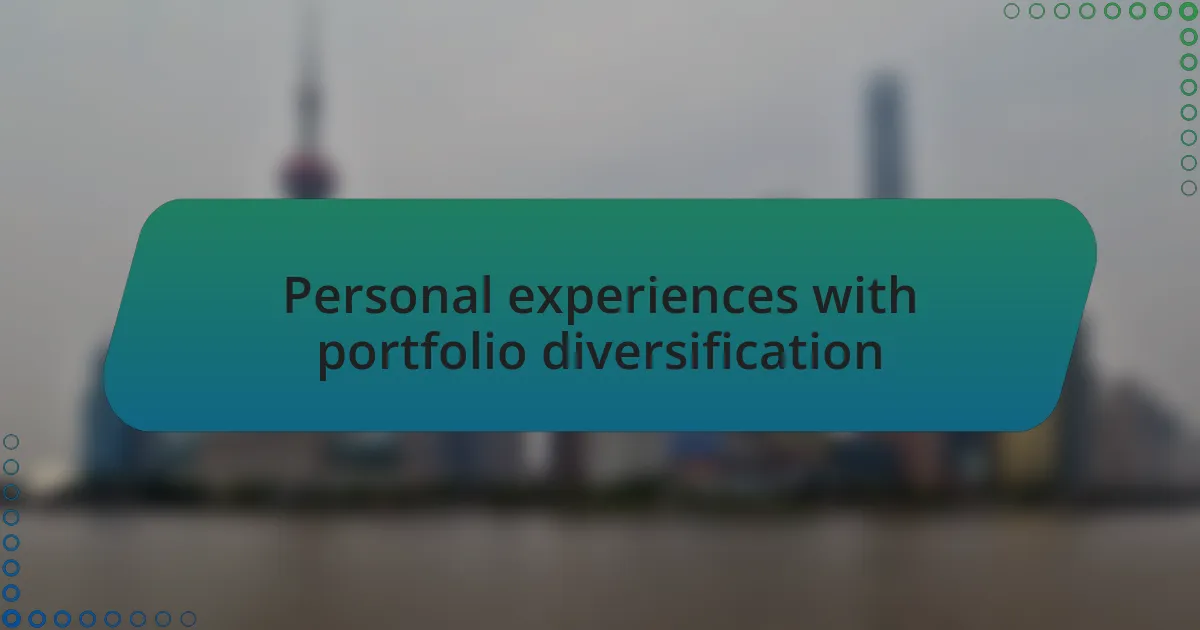Key takeaways:
- Diversification is essential for reducing risk and optimizing returns by spreading investments across different asset classes and sectors.
- Regular portfolio reviews and understanding asset correlations enhance resilience and adaptability in changing market conditions.
- Investing in various asset classes, including international markets and alternatives, opens up new growth opportunities while balancing risk.

Understanding portfolio diversification
Understanding portfolio diversification is crucial for any investor looking to reduce risk while optimizing returns. I often think about how, when I first began investing, I was overwhelmed by the sheer number of options available; it felt like standing in front of an endless buffet. It’s easy to become fixated on a single stock or sector, but I realized that spreading my investments across various asset classes could potentially safeguard my portfolio during turbulent times.
Imagine you have all your money in one company that suddenly faces a massive setback. It’s a gut-wrenching feeling, isn’t it? That’s why I’ve transformed my approach to include stocks, bonds, real estate, and even some alternative investments. Each asset class behaves differently under various market conditions, which allows for a buffer against the inevitable ups and downs of the market. This strategy not only gave me peace of mind but also taught me a valuable lesson about the importance of flexibility in investing.
Furthermore, I’ve found that diversification goes beyond just mixing asset classes; it’s also about understanding how those assets correlate with each other. For example, when stocks are roaring, bonds may not be performing as well, but they could provide stability when stocks falter. Have you ever considered how global investments can further enhance your portfolio? By venturing into international markets, I added another layer of complexity that arguably increases my growth potential while balancing risk.

Importance of a diversified portfolio
Understanding the importance of a diversified portfolio really hit home for me during a market downturn. Watching my investments plummet was tough, but I noticed that my diverse holdings cushioned the fall. It’s like having a safety net; some investments may drop, but others can remain stable or even appreciate, which keeps your overall financial health intact.
I’ve often reflected on how diversification helps to mitigate risks associated with unexpected events. For instance, during a particularly volatile period, my tech stocks suffered dramatically, but my utility stocks remained relatively unscathed. This disparity made me realize that by having various sectors represented, I was not only safeguarding my investments but also fostering a more resilient portfolio. Have you ever felt the relief of knowing that not all your eggs are in one basket?
Moreover, I’ve come to appreciate that a diversified portfolio can open up opportunities I might not have encountered otherwise. Think about it: if you concentrate on just one type of investment, you’re limiting your potential for growth. I remember the time I ventured into international markets, which not only balanced my risk but also introduced me to emerging economies that were on the rise. That leap taught me that a well-rounded portfolio is not just a defensive strategy but also a pathway to new opportunities.

Strategies for diversification
When considering strategies for diversification, I like to start with asset allocation, which involves spreading your investments across different asset classes like stocks, bonds, and real estate. I remember recalibrating my own portfolio and realizing that simply having a mix of assets reduced my susceptibility to market fluctuations. Have you ever experienced that sense of security from knowing your investments are not all tied to the same market movement?
Another effective method I’ve utilized is investing in funds that specialize in various sectors or regions. For instance, I once purchased an index fund that tracked international markets. This move not only blended my U.S.-based holdings but also allowed me to tap into growth opportunities in countries I might not have considered before. Isn’t it fascinating how a single investment can open doors to a whole new world?
Lastly, I always encourage considering alternative investments, such as commodities or peer-to-peer lending. In my own journey, including a small allocation to precious metals helped preserve my capital during economic uncertainty. It’s a bit like adding flavors to a dish—you want a mixture that complements and balances out the overall taste. What unique components could you add to your own portfolio to enhance its resilience?

Analyzing risk and reward
When I think about analyzing risk and reward, it often reminds me of a balancing act. Back when I started investing, I was drawn to high-risk stocks for their promising returns, but I quickly learned how devastating market downturns could be. That experience taught me the importance of evaluating potential returns against the risks involved—isn’t it true that every thrilling investment story often includes a cautionary tale?
As I delved deeper into investment strategies, I began quantifying risk using tools like the Sharpe ratio, which compares an investment’s return to its risk. Understanding that ratio was a game changer for me; it gave me a clearer perspective on what I was truly risking versus what I might gain. Have you ever looked at your investment options and wondered if you’re chasing returns at the expense of your peace of mind?
Moreover, I’ve found that emotional responses can cloud judgment in the face of risk. After a market dip, I often reevaluate my positions, but I try to remember that fluctuations are part of the process. The key is to remain calm and not let fear drive my decisions—after all, isn’t it much easier to make sound choices when you detach emotion from financial data?

Choosing asset classes for diversity
Choosing the right asset classes is crucial for building a diverse portfolio. Over the years, I’ve experimented with a mix of equities, bonds, and alternative investments, finding that each class brings unique strengths. I remember my first substantial investment in real estate; that move provided me with stability during stock market fluctuations, reinforcing the idea that diversity isn’t just about spreading risk—it’s also about enhancing overall performance.
I often ask myself how many times I’ve overlooked opportunities because they weren’t in my “comfort zone.” For example, including commodities like gold in my portfolio helped buffer my investments during economic uncertainty. This experience taught me that stepping outside traditional asset classes can yield surprising benefits and offers a more robust defense against market volatility.
It’s essential to consider the correlation between different asset classes as well. I’ve learned that when some sectors lag, others may thrive, creating a natural balance. Have you ever sat back and realized how certain investments complement each other beautifully? Identifying these relationships has allowed me to align my investment strategy with my long-term goals, making my portfolio truly multifaceted.

Personal experiences with portfolio diversification
Diversifying my portfolio has been a journey filled with lessons and surprises. I recall the time I decided to dip my toes into international stocks. At first, I was hesitant, fearing the unknown. However, when those investments began to pay off during a rally in emerging markets, it felt like a revelation. This experience reminded me that taking calculated risks can lead to rewards that I wouldn’t have anticipated.
I also remember the moment I realized the importance of cash as an asset class. During a market downturn, having liquidity allowed me to seize opportunities that others missed. I often reflect on how that decision transformed my approach. Have you ever felt the rush of making a timely investment that seemed risky at the moment? For me, it reinforced the idea that diversification isn’t just a strategy—it’s a mindset open to exploring every possibility.
There was a time when I focused heavily on technology stocks, thinking they would always outperform. But as the market evolved, I learned the hard way that overconcentration can be detrimental. Shifting my focus to include a mix of sectors, such as healthcare and consumer staples, not only balanced my risk but also provided a more stable return. Isn’t it fascinating how diversification allows us to adapt and thrive, even when our initial choices don’t pan out as expected? Each adjustment taught me the value of flexibility in my investments, guiding me toward a more resilient portfolio.

Lessons learned from portfolio management
Portfolio management has taught me that patience is often just as crucial as the investments themselves. In one instance, I held onto a seemingly underperforming asset for longer than I thought I should, driven by a gut feeling that change was on the horizon. Eventually, that investment rebounded spectacularly, highlighting how sometimes, the best action is to wait and trust your research. Have you ever found yourself on the edge, wondering if it’s time to cut your losses?
Another lesson came from engaging in regular portfolio reviews. Initially, I underestimated their importance, thinking that once I built a diversified portfolio, it would take care of itself. But routine reevaluation opened my eyes to shifting market trends and personal financial goals. This proactive approach not only allowed me to make timely adjustments but also deepened my understanding of market dynamics. Isn’t it enlightening how being hands-on reveals insights you might otherwise overlook?
I also learned that diversification isn’t just about different asset types; it’s about understanding how those assets interact with each other. During a particularly volatile market phase, I discovered that bonds acted as a buffer to my equity exposure, softening the blows of downturns. This experience made me appreciate the intricate dance between asset classes. How often do you consider the relationships your investments have with one another? Each revelation pushed me to think beyond simple allocation, leading me to a more holistic view of my financial health.